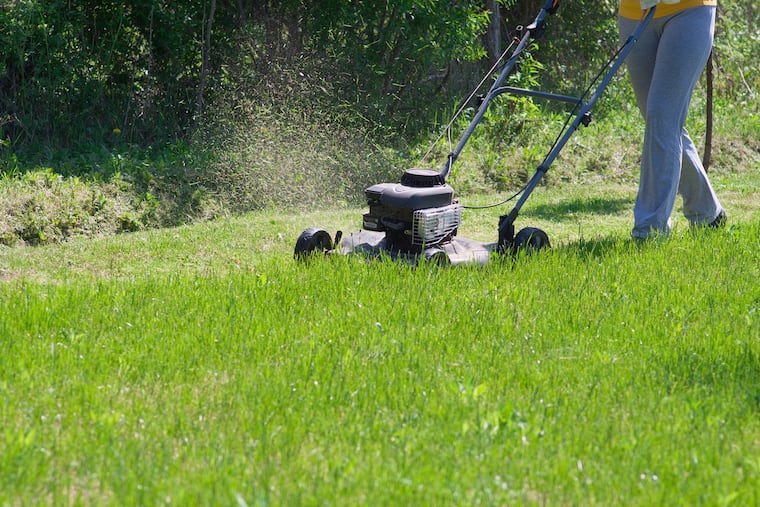Yards with less grass and more plants help fight climate change
In 2020, Americans spent $105 billion keeping their lawns verdant and neat. But our love of grass comes at an environmental cost.

Summer is officially here. For many Americans, that means blankets of grassy green for kids to play in.
There are an estimated 40 million to 50 million acres of lawn in the continental United States — that’s nearly as much as all of the country’s national parks combined. In 2020, Americans spent $105 billion keeping their lawns verdant and neat.
But our love of grass comes at an environmental cost.
According to the Environmental Protection Agency, maintaining those lawns also consumes nearly 3 trillion gallons of water a year as well as 59 million pounds of pesticides, which can seep into our land and waterways.
Department of Transportation data shows that in 2018, Americans used nearly 3 billion gallons of gasoline running lawn and garden equipment. That's the equivalent of 6 million passenger cars running for a year.
As these issues are becoming more prominent in climate change discussion, there are steps you can take to more sustainably manage the impact of your lawn, including choosing organic fertilizers, avoiding pesticides, and using electric lawn maintenance equipment
But how we care for our lawns is secondary to the amount of lawn we have in the first place, experts say. Having less grass and more plants is among the most important factors in keeping a yard eco-friendly.
“Lawn, ecologically, is dead space,” said Doug Tallamy, an entomologist at the University of Delaware and author of Nature’s Best Hope: A New Approach to Conservation That Starts in Your Yard.
The solution, he says, is ultimately less lawn. He recommends people aim to cut the amount of turf grass in their yard in half. But getting there, he says, will take a shift in culture.
America’s infatuation with grassy expanses dates to the Founding Fathers. Thomas Jefferson cultivated a lawn — previously a fixture of the European aristocracy — at his Monticello estate. By the second half of the 20th century, as the middle class grew, bought houses and spread into the suburbs, lawns had become a staple of Americana.
But, Tallamy insists, change is possible. "You can be an important part of conservation," he said. "You aren't powerless."
Laying down mulch is one place to start. It quickly kills grass and offers a blank canvas for planting.
“If you have lawn under a mature tree, convert it to a mulched area,” suggested Kathy Connolly, a Connecticut-based landscape designer who recommends about six inches of raw, arborist, wood chips for the job. Connolly also recommends converting some of your lawn into paths, rock gardens, or other features. “Ecologically, though,” she said, “the best thing to do is plant native trees and shrubs.”
Invasive plants, Tallamy said, "are ecologically castrating the land around us." Native plants, on the other hand, often have deep root structures, making them good for storing water or providing drainage. They have also coevolved for local conditions.
More broadly, Tallamy said native landscapes can help refocus our gardens on the ecological purpose of plants, which is to produce food. Plant energy gets passed up the food chain, often via insects.
Tallamy said native flora better supports native fauna and, as a result, helps combat species decline. Tallamy is a fan of oak trees, which come in 91 native species, grow almost everywhere in the country, and attract caterpillars, a key species for supporting other wildlife — to raise a clutch of chicks, a pair of robins needs between 6,000 caterpillars and 9,000 caterpillars in just 16 days, Tallamy said.
"It's not that we're being nice guys to nature," Tallamy said. "We need this, or we're in big trouble."
Others put less emphasis on nativity, and more on the diversity of species and types of plants in a yard.
"Yes, we want natives but let's be inclusive and not exclude plants that have come from somewhere," said Juliet Stromberg, a professor at Arizona State University, who was one of more than a dozen ecologists who wrote a letter arguing that a plant's origin is less important than its environmental impact.
"What I would suggest is just loosening the reins a little bit," she said. "If you're bringing in the plant that's the same genus, the insects are going to be fine."
Casey Reynolds, the executive director of Turf grass Producers International, a trade association for grass farmers, argues that grass can be a great option, especially in urban or suburban environments. One of the benefits, he says, is that lawns provide an area for people to play.
"I would never tell people to plant grass everywhere," he said. "[But] I can't enjoy my lawn if it's made up of shrubs."
The value of grass falls on a continuum, said Mark Hostetler, an urban ecologist at the University of Florida. On one hand, wild, native grasses are wonderful carbon sinks that support biodiversity. But when grass is maintained, he said, it loses many of its environmental advantages.
Hostetler said manicured lawns are “better than cement . . .(but) ecologically horrible.” Cutting the grass, he explained, rereleases the carbon that was stored in the clippings and halts the growth of other plants that may be coming in. The emissions from mowers, fertilizers, water and other types of lawn care further offset environmental gains.
Whether you choose native or nonnative replacement plants, cutting back your lawn is an admittedly difficult undertaking. Plants cost money, and landscaping takes time. Outdoor space of any sort is a luxury in many urban, low-income and minority communities — let alone the ability to prioritize plants.
“I understand that changing your landscape is a pain in the neck,” said Jim Kleinwachter, the “Conservation@Home” program director at the Conservation Foundation. But he offers an upside: “You’re going to have color through the summer instead of one thing.”